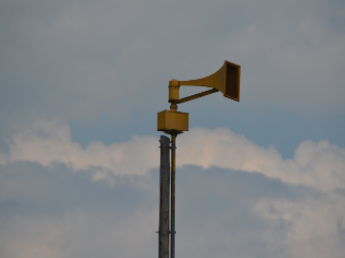Local Warning System
The Emergency Management Department provides emergency alerts and updated information during incidents in order to warn, inform, and update the general public. Public information messages and emergency warnings are broadcast over an assortment of media in an effort to reach the maximum number of people.
While a wide variety of emergency warning systems are used in Hall County and her communities, homes and businesses must be aware of these systems and how to monitor them. Depending on the original source of the information and where you may be during an incident, some media or systems may provide the information to you faster than others. The Emergency Management Department encourages everyone to employ an array of different media in order to receive vital information at the soonest possible moment.
In Hall County, the Emergency Management Department utilizes the Integrated Public Alert Warning System to broadcast emergency information over a wide range of media such as wireless phones, local media and NOAA All-Hazards Radio. The Department also manages all outdoor warning sirens in Hall County. Other external resources include internet, email, and SMS or text message services. Each system has its own strengths and delivery method.
IPAWS
The Integrated Public Alert & Warning System (IPAWS) is FEMA's national system for local alerting that provides authenticated emergency and life-saving information to the public through mobile phones using Wireless Emergency Alerts, to radio and television via the Emergency Alert System, and on the National Oceanic and Atmospheric Administration's Weather Radio.
Emergency Alert System
The Emergency Alert System (EAS) is a national public warning system to that provides emergency alert messages through local broadcasters, cable, digital radio, and direct broadcast satellite providers. The system is used by local, state or federal agencies to deliver vital information during emergencies such as natural disasters, severe weather, AMBER alerts, and civil emergencies. It is through the EAS that authorities can provide watches, warnings, alert messages, and other vital information during a disaster. Passing messages down the branches of an inter-connected network of broadcasters, the EAS system reaches significant portions of the population swiftly and accurately.
NOAA All-Hazards Radio
NOAA Weather Radio All Hazards (NWR) is a nationwide network of radio stations broadcasting continuous weather information directly from the nearest National Weather Service Office. NWR broadcasts official Weather Service warnings, watches, forecasts and other hazard information 24 hours a day, 7 days a week. The NWR is a primary input of information for the Emergency Alert System (EAS) and is the origin of the vast majority of messages.
NWR is an "all hazards" radio network, making it the single source for the most comprehensive weather and emergency information available to the public. NWR also broadcasts warning and post-event information for all types of hazards - both natural and environmental. NWR does not have to play continuously in the background. Similar to a conventional alarm clock, the NWR will sound an alert tone when emergency messages are being broadcast. With one touch of the button, you have access to accurate and timely emergency messages.
In Hall County, NWR messages are transmitted from a local transmitter located in Hamilton County providing a clear signal at 162.4 MHz and provides coverage and alerts for the counties of Buffalo, Hall, Howard, Hamilton, Merrick, Nance, Polk, York, Fillmore, Clay and Adams.
NWR devices (weather radios) are affordably priced at your local department or electronics store. The Emergency Management Department recommends you purchase a radio that features Same Coding that will allow you to program a county-specific code and avoid unnecessary alerts. For the local transmitter, those codes are:
County | SAME Code |
Adams | 031001 |
Buffalo | 031019 |
Clay | 031035 |
Fillmore | 031059 |
Hall | 031079 |
Hamilton | 031081 |
Howard | 031093 |
Merrick | 031121 |
Nance | 031125 |
Polk | 031143 |
Sherman | 031163 |
York | 031185 |
Local Radio & Television
When the EAS is activated, local broadcasters and cable or satellite providers disseminate watch and warning information through an interruption of programming. Often, information after the initial message is repeated through scrolling text at the top or bottom, and may even include map displays in the corner of the screen. Some providers may require you to change to a specific channel to receive this EAS message. Be familiar with your local media and television provider to understand the method and means that EAS messages are broadcast to you.
Internet, Email, SMS (Text Messages)
The advent of internet, email and text messaging provides countless ways of receiving emergency information. A simple internet search can produce a list of services that can alert you while at your desktop computer or your wireless device through email or text messages. Many internet services are free, though messages to your wireless devices will likely carry with them all applicable charges.
Wireless Emergency Alerts (WEA)
Wireless Emergency Alerts are emergency messages sent by authorized government alerting authorities through your mobile carrier. Government partners include local and state public safety agencies, FEMA, the FCC, the Department of Homeland Security, and the National Weather Service.
Radio Scanners
For radio scanner enthusiasts, try these frequencies :
155.820 Grand Island-Hall County Emergency Management
156.000 National Warning System (local re-broadcast)
161.730 Emergency Alert System RPU from EOC
146.940 Grand Island Amateur Radio Society
462.700 Grand Island REACT
462.725 Third City Radio Association
Outdoor Warning Sirens
The Emergency Management Department maintains and operates an outdoor warning device system of 39 sirens in each of the incorporated communities of Hall County. These devices are activated remotely by the Grand Island Emergency Center (GIEC). No "all clear" signal is given through these outdoor sirens. Anytime outdoor warning sirens are activated, homes and businesses should seek shelter immediately and monitor local media until the danger has passed. See our siren map for siren locations and 70 dB range.

Siren Activation Policy: Not Simply for Tornados
Outdoor warning sirens are activated in cases when severe weather or other hazards require residents to seek shelter. These include:
Tornado Warnings issued by the National Weather Service.
Confirmed tornados or funned clouds by NWS spotters.
Straight line winds confirmed above 75 mph.
Tennis ball sized hail (2.5" in diameter).
Large hazardous materials releases requiring residents shelter in place.
Siren Testing
Hall County tests all outdoor warning devices on the 1st and 15th day of every month at 1:00 pm for one minute. These devices feature two distinct tones:
Alert (Long) Tone: A long, solid tone is used for weather emergencies on the 1st of the month.
Attack (Warble) Tone: A warble tone which wavers up and down is employed for civil emergencies on the 15th of the month.
Depending on the siren, these devices have a range between approximately 800 and 6200 feet at 70db or more. The effectiveness of any outdoor warning device is influenced by external forces such as noise from wind, rain, hail, and thunder.
Remember, outdoor warning devices are specifically designed for outdoors and are not an effective or reliable indoor warning device. Families and business are strongly encouraged to monitor any of the warning systems listed above inside a structure.
As you employ a number of these warning systems, you will find yourself more aware and prepared to take action at the appropriate time. Be aware by receiving timely information during disasters.
Get Ready Today.

